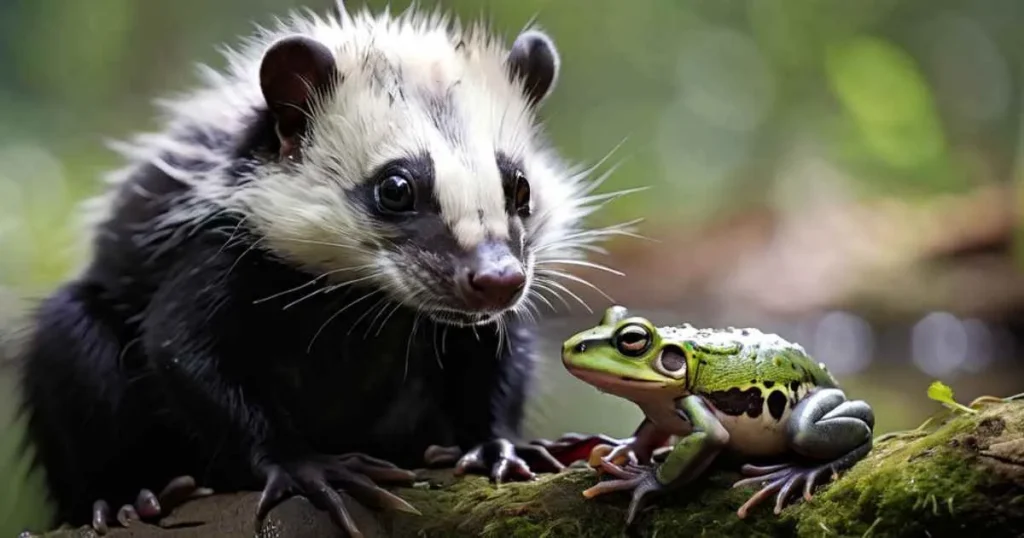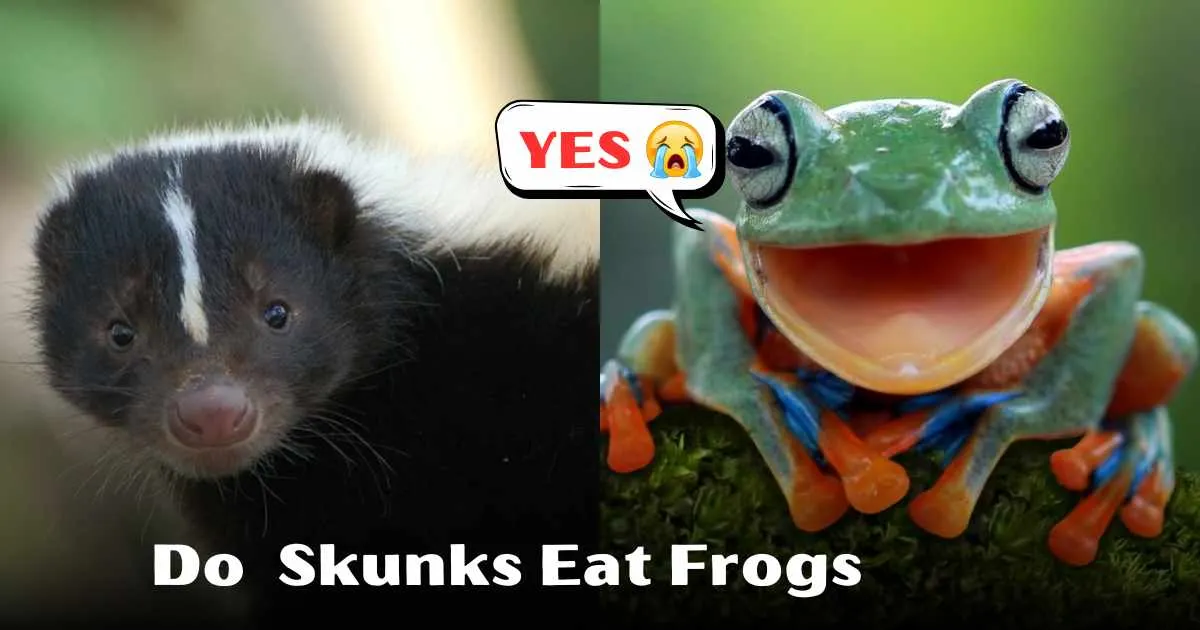Do Skunks Eat Frogs?
Last updated on June 24th, 2025 at 10:57 pm
Yes, skunks do eat frogs. As opportunistic omnivores, skunks have a diverse diet that includes insects, small mammals, fruits, and amphibians. Frogs, particularly those found near water sources where skunks forage, provide an accessible source of protein. Skunks rely on their keen sense of smell to locate prey, and their foraging habits often intersect with frog habitats. This interaction represents a natural predator-prey relationship within the ecosystem.
Skunks in the Wild
Habitat Preferences:
Skunks are highly adaptable and can be found in a range of environments, including forests, grasslands, and even suburban areas. They seek out places that offer abundant shelter and accessible food sources. Woodpiles, hollow logs, and abandoned burrows serve as refuges, while varied landscapes provide a buffet of insects, fruits, small mammals, and sometimes amphibians.
Nocturnal Lifestyle:
Primarily active at night, skunks forage under the cover of darkness. This nocturnal schedule helps them avoid certain predators and human disturbances, allowing them to capitalize on opportunities to find diverse prey, including frogs that may be active or resting near water sources after dusk.

Frogs as Potential Prey
Why Do Skunks Eat Frogs?
Frogs are a high-protein, easy-to-catch food source. Skunks are opportunistic feeders, and frogs:
Are available seasonally in large numbers
Move slowly
Are found in damp areas where skunks often forage
Ease of Capture:
Though frogs are agile jumpers, skunks possess sharp claws, a keen sense of smell, and patience. When frogs are less mobile—perhaps due to cooler nighttime temperatures or damp conditions—skunks have a decent chance of catching them. This doesn’t mean frogs are a primary target; rather, they’re an occasional treat when circumstances favor the skunk.
When Are Skunks Most Likely to Eat Frogs?
| Season | Frog Availability | Skunk Feeding Behavior |
|---|---|---|
| Spring | 🟢 High | Actively hunt frogs during mating season |
| Summer | 🟢 Medium | Feed near ponds, streams |
| Fall | 🟡 Low | Switch to insects, fruits |
| Winter | 🔴 None | Skunks enter torpor; no frog hunting |
Where Do Skunks Find Frogs?

- Garden ponds
- Creek edges
- Marshlands
- Moist underbrush
- Rural backyard water sources
If your yard has a water feature, it may attract both frogs and hungry skunks.
Are Frogs Safe for Skunks to Eat?
Most frogs are safe, but some toads release toxins that can irritate a skunk’s mouth or digestive system. However, skunks typically avoid toxic prey due to strong instincts and learned behavior.
Evidence of Frog Consumption
Research and Observations:
Wildlife biologists and researchers conducting field studies or analyzing skunk stomach contents have noted the presence of amphibian remains, including those of frogs. While not the most common prey item, their appearance confirms that frogs do feature in a skunk’s diet from time to time.
Camera Trap Footage:
Trail cameras set up in wetlands, riparian zones, or forest edges sometimes record skunks foraging. In a few cases, skunks have been documented capturing or consuming small amphibians, providing visual confirmation of these occasional predation events.
Ecological Considerations
Impact on Frog Populations:
Skunks preying on frogs introduces a natural predator-prey relationship into the ecosystem. In areas where frog populations are robust, skunk predation helps maintain balance by preventing overpopulation. However, in environments where frog numbers are low, skunk predation could potentially stress those populations.
Part of a Balanced Ecosystem:
By consuming a variety of species—including frogs—skunks help maintain ecological balance. Frogs benefit from this interplay as well; predator presence can influence their behavior, distribution, and even breeding patterns, all contributing to a more dynamic and resilient ecosystem.
Fun Fact:
Skunks can smell and hear frogs in tall grass or soil using their sharp senses, especially at night when they are most active.
Human Influence on Skunk Diets
Altered Food Sources:
In urban or suburban areas, skunks might rely less on frogs and more on human-provided resources like garbage or pet food. This shift doesn’t eliminate their capacity to eat frogs; it simply makes such opportunities less necessary. By managing waste and secure food storage, humans can indirectly influence local skunk diets.
Frequently Asked Questions
Skunks primarily enjoy insects, small mammals, fruits, and nuts. They’re not particularly selective and will adapt their choices based on what’s available.
Yes. By controlling insect and small mammal populations, skunks help maintain ecological balance. Their willingness to prey on various species, including frogs, supports biodiversity and prevents any one species from becoming overly dominant.
Easy access to food (such as insects, fruits, or human refuse) and shelter (like woodpiles or deck spaces) draws skunks to particular areas. Limiting these attractants can reduce unwanted encounters.
Conclusion
Yes, skunks do eat frogs, but frogs are just one part of their wide-ranging diet. As opportunistic omnivores, skunks thrive by exploiting various food sources. Frogs, found in damp habitats where skunks hunt, represent an occasional meal rather than a dietary mainstay. Understanding this predator-prey relationship highlights the intricate tapestry of nature’s food web, underscoring the importance of every species—skunks and frogs included—in maintaining ecological harmonyus food sources. Ensuring a biodiverse habitat can help maintain a balance between these creatures. Remember, understanding wildlife diets enhances our grasp of nature’s intricate web.

